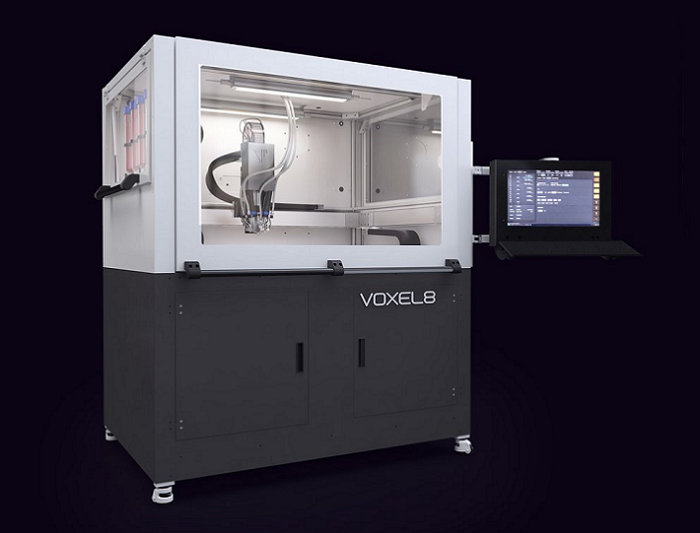HUGE Resin Printer – First Impressions of the Peopoly Phenom mSLA 3d Printer
PEAK Sports launches ‘The Next’ 3D printed footwear with Farsoon Technologies
ScanLAB to release fiberSYS additive manufacturing scan head
2019 NAMIC Global Additive Manufacturing Summit Day One
Our bellies full of hawker food we walk towards the Singapore Expo. We’re two and two becoming part of NAMIC’s Global Additive Manufacturing Summit a small part of a significant attempt of the candle power heavy nation of Singapore to become a nexus of 3D printing. A few countries are making concerted efforts to concentrate 3D printing within their borders. NAMIC is Singapore’s initiative, as 3DPrint.com we desperately wanted to engage with it because it was so research and application heavy. 3D printing research from Singapore has exploded over the past few years as have a number of very application-specific startups that together make up a core of a Singaporean 3D printing cluster. Additionally, Singapore has also managed to attract the attentions of various 3D printing companies such as Additive Industries, HP, GE with partnerships. The country has also reached out to companies such as Siemens to get them to concentrate their 3D printing efforts here. All in all, it is an irresistible effort that paper by part and MOU by MOU is layer by layer constructing a 3D printing cluster here.

And this is pretty remarkable. Long a technology powerhouse Asia has been a fast follower at best in 3D printing. Our industry is concentrated in Europe and spread out in the states. For long Asian researchers, centers and companies were far and few in between. Until the recent ascendancy of Chinese startups in low-cost FDM, Asia wasn’t really leading in any area of 3D printing. It is optimism bordering on the foolhardy to then place a stake in the ground to try to engineer an industry core here. But this is exactly what NAMIC is doing and so far they’re really making headway. The scene here is vibrant and growing quickly. Out of all the countries that have national initiatives I admire Denmark’s and Singapore’s the most since they’re getting the most bang for their buck and really spending where it counts. In sheer coordination and leveraging the experience of the country in building from nothing I believe the most in the Singaporean initiative over all others.
Also, they have the best food. Post hawker daze, therefore, we sat down to listen to Mahendran Reddy, NAMICs Business Development Director deliver his opening then Dr Ho Chaw Sing, Managing Director, NAMIC welcomed us. The Guest of Honour, Chee Hong Tat, Senior Minister of State, Trade and Industry and Education then spoke, telling us that “Additive Manufacturing will improve lives.”
Larry Lyons Vice President of Product, Desktop Metal then spoke of the company’s journey quoting some incredible print speeds. Sylvia Monsheimer Head of Market Segment N3D, Evonik Germany spoke of high-performance materials while Benjamin Moey Vice President, Additive Manufacturing (Asia Pacific), Siemens wants to design materials for industrial additive manufacturing as well so perhaps they should get together.
Javier Fernandez of Chitonous gave a fascinating presentation on biologically inspired materials. He spoke of biomaterials for “$6 a kilo, the prices of engineering plastics.” Chitionous takes chitosan and other “abundant biomaterials” and takes products such as shrilk which is an artificial insect skin material that can be used by industry. Some of these materials are 3D printable and the company has made 5-meter tall parts out of biomaterials from Singapore. Chitonous’ vision is for local recycling to collect and use biomaterials locally.
Volker Hammes Managing Director BASF New Business GmbH, talked about collaborating on materials fit for purpose. He spoke of BASF’s broad materials portfolio in 3D printing and their willingness to look hard and deep at using in-process waste for new more efficient materials. He also explained that the company was now scoring all new materials on competitiveness and sustainability and will move into more sustainable solutions.
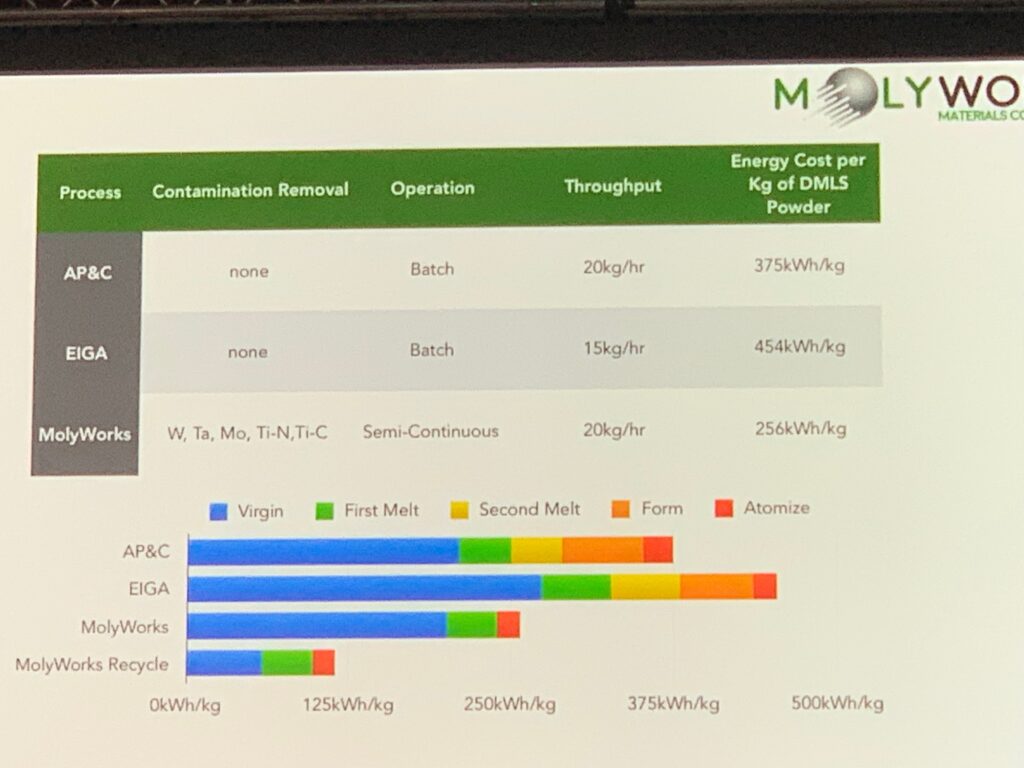
Christopher Eonta the Founder and CEO of the MolyWorks Materials Corporation where he detailed how they were developing a containerized atomization solution that could take a wide array of scrap materials and turn them into 3D printing powder for metal printers. The company has several NSF and US Military grants and is now trying to take $1.40 a pound scrap into $ 95-pound powder and then $1100 a pound aerospace parts. The relatively lower energy costs were very exciting as was the company’s grasp of the value chain.
All in all it was an exciting and thoughtful day and I’m looking for tomorrow.
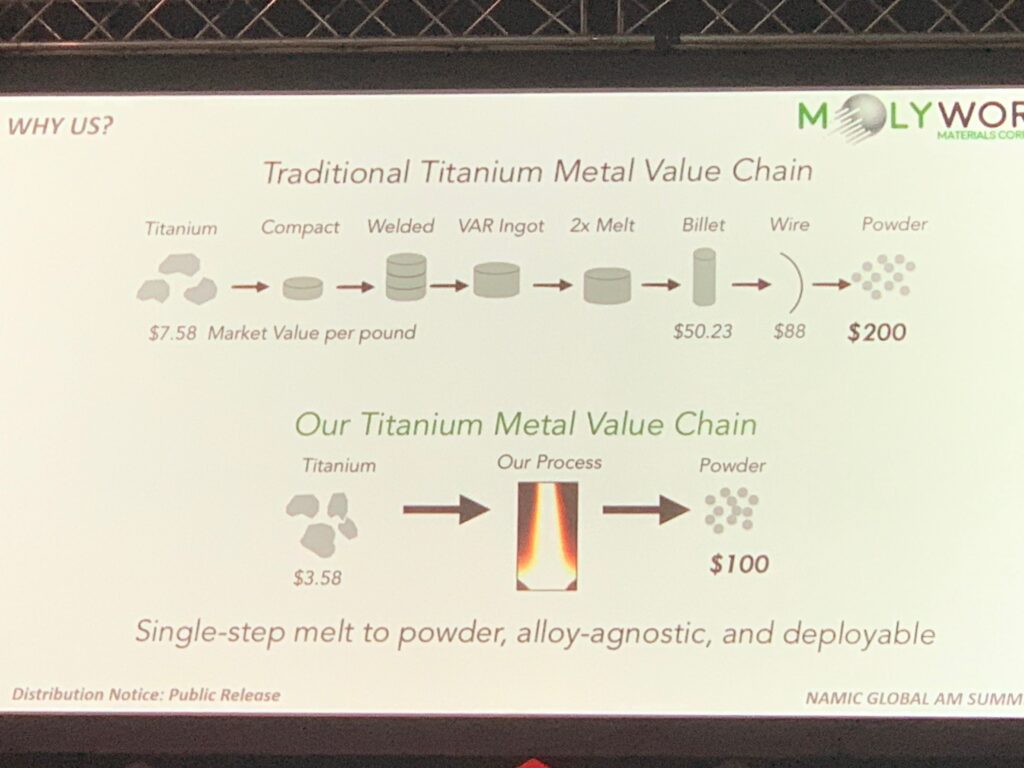
The post 2019 NAMIC Global Additive Manufacturing Summit Day One appeared first on 3DPrint.com | The Voice of 3D Printing / Additive Manufacturing.
Meltio: An International Joining of Forces to Revolutionize the 3D Market
Meltio is a new company specialized in applying additive manufacturing and 3D scanning to industrial sectors such as aerospace, architecture, automotive, medical, education, electronics, and machining. It was set up in mid-2019 as a joint venture with the participation of Additec, an American company based in Las Vegas, Nevada, Sicnova, a Spanish company with a vast history in the 3D field, and with a significant participation of metallurgical giant ArcelorMittal.]

Its goal is to boost the industry by improving productivity, by means of a wide portfolio of connected and scalable technological solutions based on advanced 4D manufacturing and 3D inspection. All this can be summarized with the introduction of its 3E Technology concept: Easy, Efficient and Expandable.
Meltio’s product portfolio offers several complementary alternatives, turning Meltio into a global partner for companies willing to implement 4.0 solutions targeted to make their workflows more efficient. The products catalog includes large format FFF 3D printers, 3D digitalization solutions for inspection and quality control, and also hybrid systems (CNC/robotic engines or modules). This way Meltio will enable the acquisition of digital 3D files to producing plastic prototypes or metal end use parts with great surface finish, and ultimately controlling the quality of the parts with automated inspection systems.

Meltio is soon launching at Formnext2019, one of its flagship solutions: Meltio M450 3D printer. This new printer is based on LMD technology previously used by Additec in its µPrinter. MELTIO M450 uses a high-power multi-laser printhead able to handle metal wire or powder without changing the nozzle. The printer features a very compact format which makes it suitable for desktop environments, with a build volume of 200x150x450 mm.

In the words of the CEO of the company Ángel Llavero, “the joining of forces of Additec, Sicnova and ArcelorMittal will make possible a democratizing access to direct metal 3D printing, by allowing its use to many companies that could not afford it until now”.
Meltio has set up since the beginning as an international company with a clear global vision and offices in United States and Spain. The main headquarters and factory are located in Linares, Jaen (Spain), with the R&D centers in both, the US and Europe.
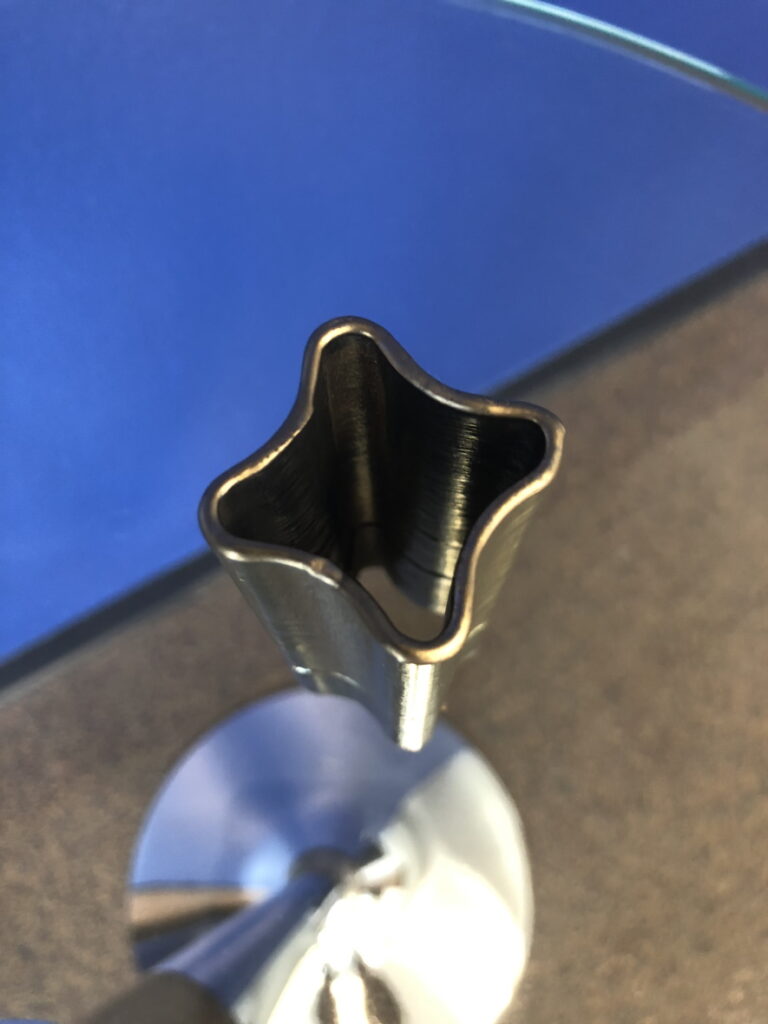
The company is led by several names with extensive experience in 3D technologies sector. The CEO is Ángel Llavero (also CEO in Sicnova since 2007) and the main board also includes Brian Matthews (CEO of Additec). Also the CRO is Oscar Meza, former Vice-President of Global Sales at Shining3D, Executive Vice-president of Worldwide Sales at Creaform and Vice-President of Sales in Asia-Pacific at Faro Technologies.
Currently Meltio is closing international deals for distributing its portfolio worldwide. The complete range of products will be showcased at Formnext (stand C111, hall 12.1), where it will also host an official presentation the first day of the event (Tuesday, 19th November at 2.30 PM). You can get invitations for visiting the stand at Formnext through Meltio’s website: meltio4d.com.
The post Meltio: An International Joining of Forces to Revolutionize the 3D Market appeared first on 3DPrint.com | The Voice of 3D Printing / Additive Manufacturing.
Markforged opens new facility to support 3D printer materials production
Voxel8 Announces Series B Funding Round to Advance Its Multi-Material Digital Fabrication
 Massachusetts-based Voxel8 was co-founded in 2014 by an interdisciplinary team of scientists and engineers from Harvard University, led by Dr. Jennifer Lewis. The company is working to develop digital manufacturing systems that will change up how we design, manufacture, and sell footwear and athletic apparel around the world.
Massachusetts-based Voxel8 was co-founded in 2014 by an interdisciplinary team of scientists and engineers from Harvard University, led by Dr. Jennifer Lewis. The company is working to develop digital manufacturing systems that will change up how we design, manufacture, and sell footwear and athletic apparel around the world.
Not long ago, the company introduced its multi-material ActiveLab Digital Fabrication System, which allows for the product development, wear testing, and production runs of high-performance athletic shoe uppers, in addition to other textiles. It’s designer-friendly, enabling automation and customization with zero tooling costs. The system uses ActiveMix extrusion technology to build 3D structures and thick films with variable cross sections directly on to textiles.
The 600 kg printer, with a 600 x 430 mm build platform, allows users to digitally design and fabricate shoe uppers, and is transforming how we develop and manufacture footwear and athletic apparel today. The system offers shorter manufacturing reorder lead times, significantly reduced design cycle times, and much lower costs for freight, labor, tariffs, and tooling. This gives customers the ability to design shoes, and other textile products, that include structural features and complex designs with little extra cost – affording them the opportunity to set up manufacturing facilities that are located closer to major end-user markets, like Europe and North America, and respond much faster to consumer demand.
Voxel8 seems to be doing pretty well for itself, and has just announced a Series B investment funding round, which was led by DSM Venturing – the venture investment arm of Royal DSM.
“Voxel8 is an excellent addition to our portfolio. Its multi-materials digital manufacturing platform is poised to dramatically impact the footwear and the sports apparel markets, strategic to DSM,” stated Pieter Wolters, Managing Director for DSM Venturing.
Additional participants in this round of Series B funding include HP Tech Ventures, as well as ARCH Venture Partners and Braemar Energy Ventures – two of Voxel8’s existing investors.
“Voxel8 is uniquely differentiated as a leader in multi-material digital manufacturing, which we believe will meaningfully expand the realm of possibilities for digitally manufacturing a wide range of products. Within the athletic footwear market alone, over 2.5 billion pairs of athletic shoes are manufactured globally each year,” said Jiong Ma, Braemar Energy Ventures. “Voxel8 is well-poised to capture substantial market share in athletic shoe upper manufacturing and, more broadly, medical and smart textiles.”
The company will use the funding to continue advancing its multi-material digital manufacturing.
“Our digital manufacturing systems are revolutionizing how footwear and athletic apparel is designed, manufactured, and sold to consumers across the globe,” said Travis Busbee, the CEO and co-founder of Voxel8. “We are excited to work with this team of world-class and experienced investors. Their global reach, expertise, and funding will accelerate the rapid adoption of Voxel8’s technology for high-volume production of athletic footwear and apparel.”
What do you think about this news? Discuss this story and other 3D printing topics at 3DPrintBoard.com or share your thoughts in the Facebook comments below.
[Images: Voxel8]
The post Voxel8 Announces Series B Funding Round to Advance Its Multi-Material Digital Fabrication appeared first on 3DPrint.com | The Voice of 3D Printing / Additive Manufacturing.
How 3D Printing Jigs and Fixtures Transforms Manufacturing
In the industrial world, 3D printed jigs and fixtures are truly unsung heroes. Both jigs and fixtures are types of tools that are used to control the operation of another instrument. However, a fixture sets itself apart in that it’s mainly used to hold another tool or device in place during the manufacturing process.
As a manufacturer, in any industry, you rely on essential components like jigs and fixtures to get the job done. The difference is that these days, more and more manufacturers are realizing massive productivity increases and lowered costs by 3D printing these essential manufacturing aids.
In this series of articles, we will layout the benefits of using additive manufacturing to produce Jigs & Fixtures. The first part will focus on Jigs. To find out more about how you can harness the potential of 3D printing jigs and fixtures to increase productivity and reduce costs, read on.
Jigs 101
Jigs are custom-made tools that hold in place and control the motion of other devices or parts in the manufacturing process. Unlike a fixture, a jig lets manufacturers expedite the assembly or construction of a product by allowing for greater interchangeability and repeatability.
It should come as no surprise, then, that jigs are a staple in virtually all mass-production systems in the developed world. However, small and medium-sized firms traditionally haven’t been able to create custom-made jigs until the arrival of 3D printing technologies.
Why 3D Print Jigs and Fixtures?
Most companies cannot afford to splurge on traditionally manufactured jigs and fixtures to add to their assembly lines or build processes. Thanks to the advent of additive manufacturing, productivity-enhancing tools such as jigs, fixtures, and grips can now be produced at a fraction of the cost of their traditionally made counterparts.
Producing jigs and fixtures via 3D printing is a highly cost-effective means of speeding up your assembly times and reducing labor costs. Plus, on-demand jig and fixture production eliminates upfront inventory requirements. Instead, digital inventory allows for seamless updates and revisions to keep your equipment working the way it should.
Other benefits of 3D printed jigs and fixtures include weight reduction (via high-strength plastic construction), ergonomic superiority (via customizable item contouring and shaping) and reducing overall complexity during the manufacturing process.
Here are examples of jigs that you can 3D print today:
Router Corner Jig
Built with black versatile plastic, a SLS nylon 12, this woodworking tool is designed to create precise cuts around angular corners during woodworking. A workshop essential, this 3D-printed tool allows users to make consistent cuts around edges when using a Router tool.
Cutting corners has never been easier thanks to this corner jig, which holds to the corner of your working piece to guide cuts at an exact and consistent radius.
Rotary Tool Drill Bit Sharpener Jig
Constructed with multi-jet fusion plastic, smooth black nylon 12, this rotary drill bit sharpener tool is the DIYers dream. This jig sharpens dull drill bits to their original condition by crafting a new cutting edge on the side of the tool. The process is simple: the jig attaches to a rotary tool and a grinding disc.
Then, the drill bit is inserted into the jig at the correct angle. The jig, in conjunction with the abrasive disc, proceeds to grind the drill bit to the user’s preferred degree of sharpness in seconds.
Center Point Finder Jig
This time-saving jig tool streamlines your assembly processes by allowing you to locate the midpoint of objects with varying levels of thickness. Made of durable red versatile plastic, a SLS nylon 12, the Center Point Finder Jig works according to a simple process: the jig is placed on top of an object that the user wants to measure, then the jig is twisted until the pegs cannot move any further. Then, the indicator in the center of the jig signifies where the midpoint of the object is.
Ready to Save Money for Your Company?
There has never been a better time to invest in jigs, fixtures, grips, and other tools that can save your company time and money when manufacturing. Typically, a jig or fixture would be sent away to be produced by a trained machinist for days at a time.
Today, 3D printing has cut down production times and created a more affordable alternative for manufacturers in need of custom-made assembly tools.
Interested in learning more about how 3D printing can impact your business by increasing productivity and lowering production costs? Get in touch today to learn how Shapeways, the leading end-to-end 3D printing fulfillment platform, is helping millions of companies leverage 3D printing to scale their businesses.
The post How 3D Printing Jigs and Fixtures Transforms Manufacturing appeared first on 3DPrint.com | The Voice of 3D Printing / Additive Manufacturing.
The Stratasys J850 3D Printer: Just Released—Designed for Designers / Also New FDM Thermoplastics
With today’s release of the J850 3D Printer, a full-color, multi-material PolyJet system, Stratasys meets its goal to continue pushing the boundaries—now they want to give us the ability to take ‘rapid prototyping’ to the next level.
3D Printer, a full-color, multi-material PolyJet system, Stratasys meets its goal to continue pushing the boundaries—now they want to give us the ability to take ‘rapid prototyping’ to the next level.
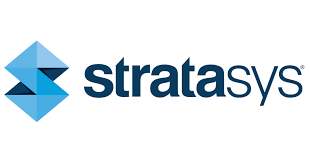 The J850 offers:
The J850 offers:
- Increased productivity with super high-speed mode
- Seven material capacity enables more color, transparency, flexibility
- Extremely high-quality prints and better part refinement
- Modeling time reduction of up to 50 percent
- Reduced time to market
“Stratasys PolyJet technology gives designers endless possibilities. With this solution, there’s no need to add or switch technologies throughout the design process,” said Alex Padwa, the Founder of Padwa Design, a premier industrial design studio building solutions for consumer goods, high technology, and the household.
“We can immediately achieve the exact design intent we have in mind – and bring it to life in our hands instantly. The J850 is truly designed for designers.”
Stratasys is also releasing two new PolyJet Materials:
- VeroUltraClear material delivers detail and clarity, with an appearance like glass. This new clear material helps designers envision internal features and fabricate exceptional prototypes.
- DraftGrey
 is an affordable new material for creating prototypes in the initial project stages.
is an affordable new material for creating prototypes in the initial project stages.
The J850 also supports PANTONE Validated color, encompassing ‘a universal language of color’ for realism in prototypes and reliability in every stage of the creation process in 3D printing. The J850 is also supported by GrabCAD Print software, eliminating the need to convert .stl files.
“The new J850 has been built to meet the needs of the full design process in industries such as consumer goods, consumer electronics, automotive, as well as education settings,” said Shamir Shoham, Vice President, PolyJet Business Unit at Stratasys.
“Typically, that process includes two separate streams: evaluating geometric shape with a physical single-color model and considering color and texture on the screen. The J850 merges these two mediums into one full-color, multi-material model to make better design decisions, earlier.”
Stratasys will provide existing J750 customers with a straightforward on-premise upgrade path to the J850.
Also taking care of their ever-growing client base of engineers, Stratasys is releasing a line of new temperature and chemical resistant FDM thermoplastics for high temperatures and ‘challenging requirements’ in use:
- Antero 840CN03 – for the Stratasys Fortus® F900 FDM 3D printer, this is the second PEKK-based polymer from Stratasys, created for users with high customization needs and parts with consistent electrostatic discharge (ESD) performance.
- Diran 410MF07 and ABS-ESD7 – for the Stratasys F370
 3D printer, this is a nylon-based material offering added toughness and low-friction. ABS-ESD7 is made for static-sensitive applications and ‘ideal’ for tooling applications.
3D printer, this is a nylon-based material offering added toughness and low-friction. ABS-ESD7 is made for static-sensitive applications and ‘ideal’ for tooling applications.
“Manufacturing spacecraft poses intense material challenges in the development of parts that exhibit the right attributes,” said Brian Kaplun, Senior Manager for Advanced Manufacturing, Lockheed Martin Space. “One of those challenges is getting the right ESD or electrostatic dissipative properties, among other physical and mechanical characteristics. Stratasys Antero ESD fits our needs for outgassing and electrostatic dissipative properties in a strong but lightweight additive manufacturing material.
“We see growing adoption of 3D printing in production environments, yet engineers and designers struggle with thermoplastics that just can’t match the extreme requirements of manufacturing-based applications,” said Adam Pawloski, Vice President of Manufacturing Solutions at Stratasys. “Our thermoplastics can remove these barriers to accelerate the adoption of 3D printing in manufacturing settings, allowing users to design and create faster, while minimizing costs often associated with traditional approaches.”
Stratasys has been lighting up the 3D realm with its PolyJet system and new materials for years now, highlighting incredible projects spanning everything from fashion and wooden structures to advanced medical models. What do you think of this news? Let us know your thoughts! Join the discussion of this and other 3D printing topics at 3DPrintBoard.com.
[Source / Images: Stratasys]
The post The Stratasys J850 3D Printer: Just Released—Designed for Designers / Also New FDM Thermoplastics appeared first on 3DPrint.com | The Voice of 3D Printing / Additive Manufacturing.

